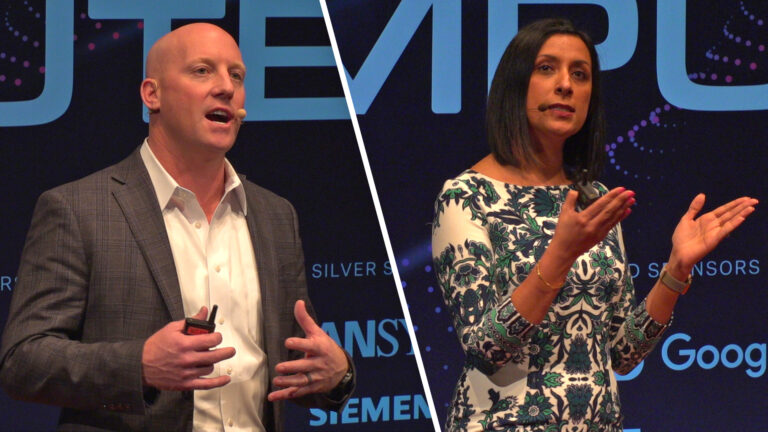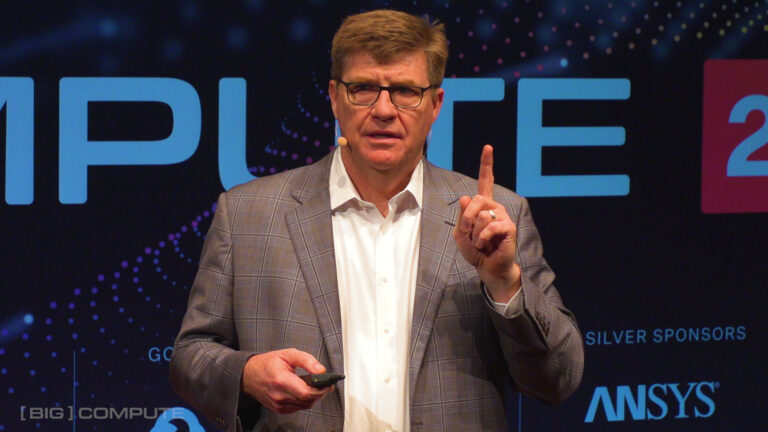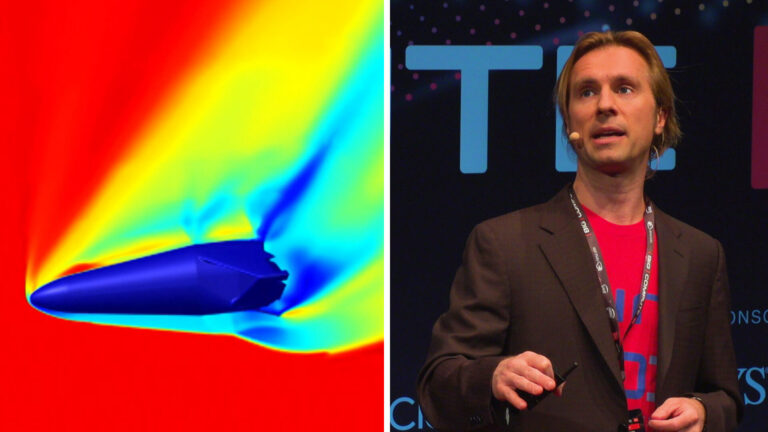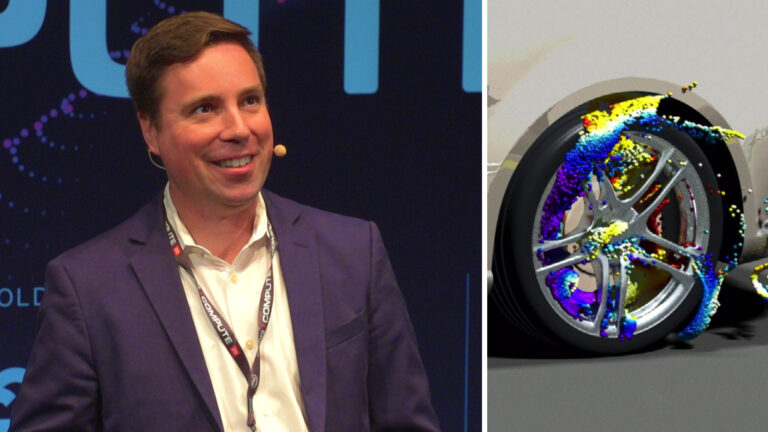How Unlimited Computing Power Transforms Mobility – Kelly Senecal, Convergent Science
Speaker:
Please welcome to the stage the founder of Convergent Science, Kelly Senecal.
Kelly:
Okay, so the question of the day is, if we had infinite computing power, what would we do with that? How would we use that to improve our world?
Kelly:
Now, I would use it to find the perfect combustion recipe, the greenest engine possible, an engine we can hug and feel good about it. Now, I know a lot of you are probably thinking “Internal combustion engines? That’s old technology and aren’t those dead?” And I know why a lot of you would feel this way. The diesel gate scandal effectively killed internal combustion engines in a lot of people’s minds. Now, if you’re not familiar with diesel gate, one of the leading automotive companies intentionally programmed emissions controls in some of their engines to only activate during lab testing, but not under real world driving. So this scandal left a huge stain on the internal combustion engine and the media. You probably remember this headline, this is from a few years ago, one of the more famous ones from The Economist where the internal combustion engine is dead on the side of the road depicted as roadkill. And actually 2017 was a brutal year for the internal combustion engine in the media and it continues to be that way.
Kelly:
So hopefully if there’s any media in the audience, they’ll take offense to this, but I want you to at least, for the next 20 minutes, forget about the media. Do me a favor, open your minds and hear me out on why I think it’s not only important but necessary to keep improving the internal combustion engine.
Kelly:
There are over one billion cars on the road, and 99% of them are powered by internal combustion engines. And here’s some really cool data from the Bureau of Transportation statistics, this year alone, we will drive over 3.2 trillion miles. That’s 3.2 trillion with a T. Put another way, this is a hundred thousand miles per second. These numbers are staggering. And given these numbers, it’s no surprise Earth has a fever and greenhouse gases are believed to be the culprit. So let’s look at the global greenhouse gas emissions by sector. So this is worldwide. So transportation results in about 14% of these and more specifically, road transportation is 10%. And we’ve done a lot over the years to improve this, to try to improve this, the combination of government mandates and engineering innovation, we more than doubled our fuel economy since 1975, but we have a lot more that we need to do. We have to take that 14% and shrink it down as much as we possibly can.
Kelly:
But you’re probably thinking, “We have the answer to this already. We have the silver bullet technology, battery electric vehicles.” As we still often refer to these, they’re zero emissions. They have no tailpipe, so how can they pollute? Some might say the future is electric. Well, let’s shift that around a little bit. I actually would rather say the future is eclectic and I’m going to tell you why here in the next few slides. In fact, there is no silver bullet technology to transportation. So this cartoon does a nice job summarizing this. In the top picture, the man driving the diesel powered vehicle is sad. He feels dirty. And as a side note, the black smoke coming out the tailpipe, diesel engine vehicles are much cleaner than this now, especially with aftertreatment systems. But anyway, let’s come back to the cartoon now. In the bottom, the guy driving the car’s really happy, he’s driving an electric vehicle. He feels very clean. But unfortunately in a lot of parts of the world still, electricity comes from fossil fuels.
Kelly:
So let’s look at that in a little more detail. In the US in 1985, almost 70% of our electricity came from nonrenewable sources. In other words, fossil fuels. 30 years later, that number didn’t really change. And still today it’s between 60 and 70%. now, we’ve had a positive transition from coal to natural gas, and that’s great, but that’s still fossil fuels. And it turns out that in different places in the world, this looks very different. China, you can see, about 75% nonrenewable. Norway, on the other hand, only about 10%, so 90% of their electricity comes from renewable sources. And in this case, hydroelectric power. So again, this looks very different throughout the world.
Kelly:
So given that background, I’m going to ask you to rethink emissions today, at least for the next 20 minutes. And what do I mean by that? Normally when we think about emissions from vehicles, we think about just the tailpipe. And that makes sense, that’s where the exhaust comes out, but there’s more to it than that. A lot more to it. Even on the vehicle level, whether you’re driving an electric vehicle or a gasoline-powered vehicle, there are other sources of emissions. In particular, you can have non exhaust particulate emissions generated from the tires and the brakes, and that doesn’t matter what type of vehicle you’re driving. And that particulate matter level is on par with the exhaust level, so that’s something we have to think about as well.
Kelly:
And then as we saw in that cartoon earlier, we also have to worry about the power plants. It’s not just about the vehicle. So we have to draw our circle around also the power plants. How are you creating electricity that’s charging your car? And this is such a complicated problem that really we have to do a life cycle analysis and include everything, every piece that that car touches.
Kelly:
So I’m going to show an example of a life cycle analysis from Kawamoto et al, and they’re from Japan, and this was published in the Journal of Sustainability just last year, so recent data. And here you’ll notice I’m plotting CO2 emissions as a function of driving distance. And there are three different phases in this plot: the production phase, which has that thin band around zero, so this is how much CO2 manufacturing the vehicle produces before you’ve even driven it off the lot; then you have the use phase, the big area in the middle, and then you have the end of life. Now this is average data first for the European union. That’s what the EU stands for. So let’s first look at a gasoline vehicle.
Kelly:
So as you notice in the production phase, we have non-zero CO2. It requires energy to create that vehicle. And then as we drive that vehicle, we have fuel combustion, we have fuel production, we have maintenance, we create more and more CO2 as we drive it. And then recycling wasn’t considered in this study so at the end of life it just flattens out. Now let’s look at a diesel vehicle, very similar story. The production of a diesel vehicle is very similar in terms of CO2, but diesel engines are more efficient than gasoline engines and so they produce less CO2 over their lifetime on average.
Kelly:
Now let’s put a really interesting line on here, the yellow line is the battery electric vehicle. So one thing that’s really interesting here is look at the production phase, the CO2 is quite a bit higher than the conventional vehicles, and this is mainly due to the battery production. So these long range batteries can be very CO2 intense. And then you have the use phase and you notice a crossover point. And if you look at the yellow line compared to the red line, that crosses over at about 110,000 kilometers or 68,000 miles, about five years of driving. So it takes about five years of driving that battery electric vehicle on average in the EU to pay back the CO2.
Kelly:
And then if you have to replace your battery pack, say at 160,000 kilometers, that gives you another bump up in CO2. But at the end of the day here, the battery electric vehicle has less CO2 than the gasoline vehicle over its lifetime, slightly more though than the diesel vehicle. And this looks very different in different parts of the world. So we also looked at Japan, Australia, China, and the US. And the moral of the story here is depending on where you are in the world, sometimes the battery electric vehicle is cleaner, sometimes the battery electric vehicle is not as clean as a conventional vehicle.
Kelly:
Okay, so let’s ask ourselves this question and hopefully everybody maybe knows the answer to this question. My 13-year-old son wrote this out last year for his eighth grade science project. Please forgive his spelling mistakes. He’s really good at math so I let the spelling mistakes go. So this question is what is the most climate friendly today, a car with an electric motor or a car with an IC engine? So when I heard this was his science project, I got super excited. I thought this is a way we can finally bond over school. And so I said to him, I said, “Buddy, you know who your best resource for this is, right?” And he looked at me confused and he said, “The internet?” And so anyway, that was a little bit disappointing, but what I was very proud of is his answer. His answer is it depends. And it does depend. It depends on a lot of things, some of which we’ll talk about today. And then of course he went on and explained why.
Kelly:
So the other thing we have to think about when we talk about battery electric vehicles versus internal combustion engines is the infrastructure. So gas stations are ubiquitous. Now, charging stations are growing, and in California here actually you guys have a lot of charging stations, but they’re still far from everywhere in the US and everywhere in the world, so something we have to consider.
Kelly:
The other thing is mining. Mining the lithium to create these batteries does damage to local ecosystems and salt flats. There are also human rights issues when you talk about mining for cobalt. And then also, by the way, what do you think is powering that mining equipment? Internal combustion engines. So, what do we do? So I’ve talked about pros and cons of these different propulsion technologies, what do we do? So my recommendation is we maintain diversity and transportation. So depending on where you are in the world and what application you have, a battery electric vehicle may be the best answer, an internal combustion engine vehicle may be the best answer. But another really good diversification strategy, which I think we should be putting much more effort into, is the hybrid vehicle. The hybrid vehicle includes both an internal combustion engine and an electric motor. And if you drive this correctly, which is a big if, you can get the best of both worlds. And actually contrary to popular belief, hybrid electric vehicles are the fastest way to reduce CO2 from transportation, even faster than battery electric vehicles. And this has to do with the amount of battery resources that we need.
Kelly:
So here’s another cool thing we can do with hybrids, we can use geo-fencing. So as you’re driving into a city, a low emission zone in a city or a highly polluting urban area, your car can transition to just running on the electric motor. As you leave the city, then you can go back to the internal combustion engine. So this alleviates some of the issues we talked about infrastructure, range anxiety, and it’s a quick way, it’s a very quick way, to reduce local pollution in cities.
Kelly:
The other thing we can do to power those engines is we can use renewable fuels. So there’s this misconception that we have to use fossil fuels to power these engines, we can use things like biofuels and e-fuels. There’s still work to do, still more research has to be done to make this a scalable process, but just like we’re trying to make our electricity sources go more renewable, we can make our liquid fuels go renewable as well. But given that, we still have to find the most efficient and the cleanest engine so we want to use the cleanest engine in our hybrid vehicle. So really what we’re looking for is finding the perfect flame.
Kelly:
Now, an engine has all kinds of variables, fuel injection, spark timing, spark parameters, airflow, geometric parameters, too many to name here, so there’s no way we have the optimum, but we need to find that optimum. And this is where infinite computing can come in and help us, so we can use the infinite computing to help us find the optimum. But to do that, we use computational fluid dynamics or CFD. So CFD, for those of you not familiar, is a way to replicate the physics of a problem, a flow scenario, in this case in the engine, on the computer so you don’t have to build it. And it’s much more efficient and hopefully less expensive way to generate a lot of different designs and analyze them.
Kelly:
So we have something called autonomous meshing, not autonomous driving, but similar. It’s where instead of having to make a match for the CFD manually, which for years and years and years has been a huge bottleneck for CFD, now we do it autonomously. So the mesh is made automatically for you. We use something called adaptive mesh refinement, and what that does is it places the mesh in space and in time where it needs to be to accurately resolve your flow situation.
Kelly:
But you also need massive scalability. If your CFD code doesn’t scale on lots and lots of cores, infinite computing isn’t really going to help you, so we need to be able to break up the problem and ship it off into lots of different processors and have those processors work on different aspects of the domain in parallel. So recently we’ve made huge breakthroughs with our software and we now can scale on thousands and thousands of cores and we get near ideal speed up. This is a huge leap into using infinite computing because now we can scale on thousands of cores.
Kelly:
So typically when we would do CFD, we would either do capacity computing or capability computing. And what capacity computing is is we would run lots and lots of simulations at once in parallel to very quickly look at the design space. Capability computing was running a highly resolved domain so you get a really good answer, so you can trust your answer because you have a lot of resolution and you’re capturing the physics better. So we would pick one or the other if we got a lot of cores available to us. With infinite computing, we can now marry these two concepts. And this is critical for coming up with these cleaner engine designs because now we can run highly resolved simulations on thousands of cores and run thousands of them simultaneously. And this is going to get us the optimum that I talked about earlier.
Kelly:
So we’ve been doing some of this recently. We worked with Aramco Research and Argonne National Laboratory, and we actually received the Editor’s Choice for the Best Use of HPC in Automotive. And what we did is we looked at a gasoline compression engine and we ran it on thousands of cores and we ran thousands of these simultaneously using supercomputing and also machine learning, and we were able to design the most efficient and cleanest version of this engine. And then this engine was built for real, in real life. And they ran the engine and it actually behaved very similarly to what we predicted. So this was a huge success story, not only for CFD, but for CFD and HPC and using this concept of infinite computing.
Kelly:
So, where does this leave us with mobility? We’re in really uncertain territory here in the automotive industry. Are we going to go all electric? Are we going to go hybrid? Are we going to do a combination? What are we going to do, renewable fuels? So we like silver bullets and we like things to be simple. That makes things easy, but this is really far from simple. So we need a diverse set of propulsion technologies to help meet all of our needs in transportation, and infinite computing is what’s going to help us get there. So I’m going to tie into my title here, and you can groan if you want to, but we need big compute for the big commute. Like that? Okay, so thank you very much.






